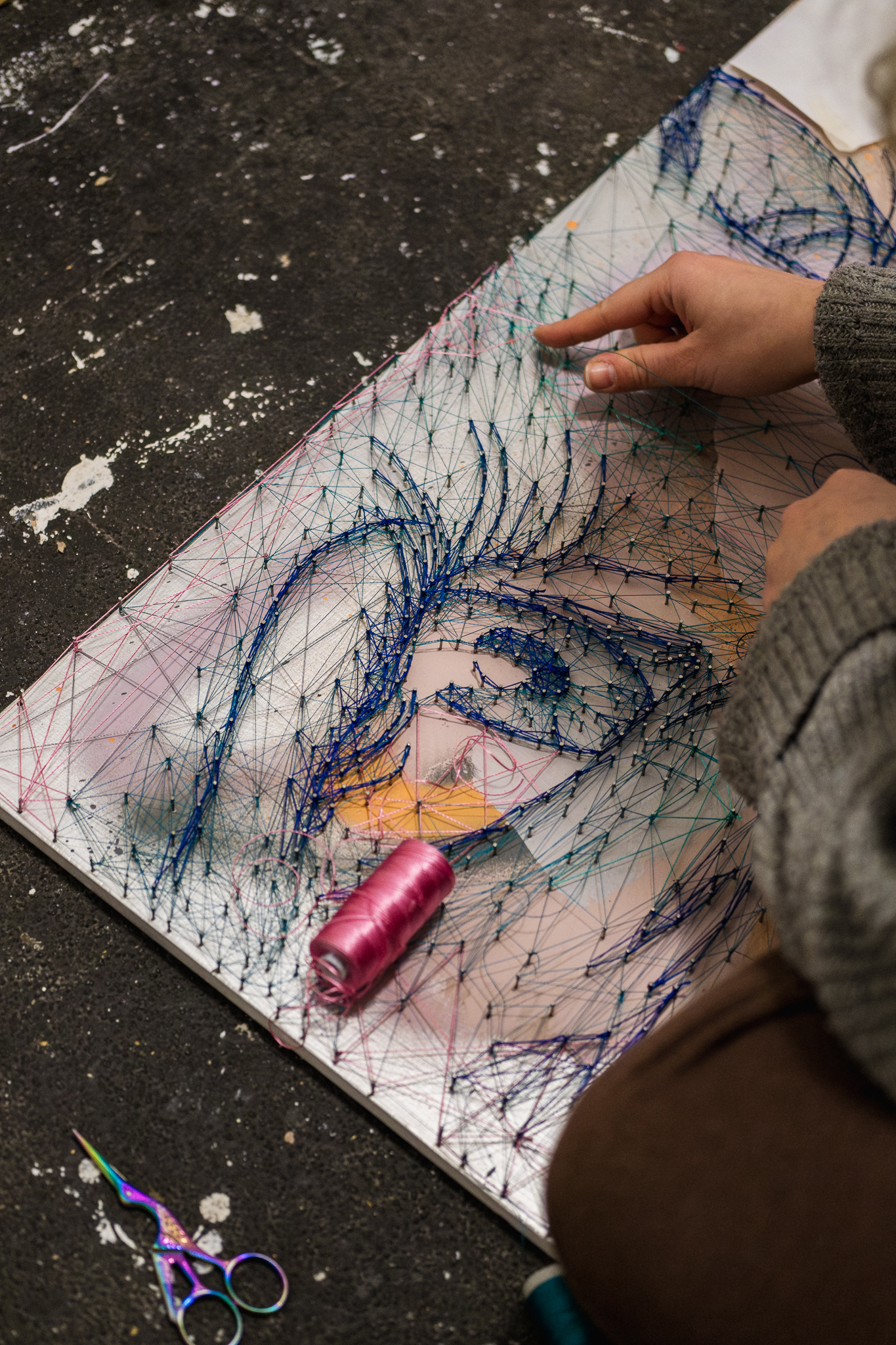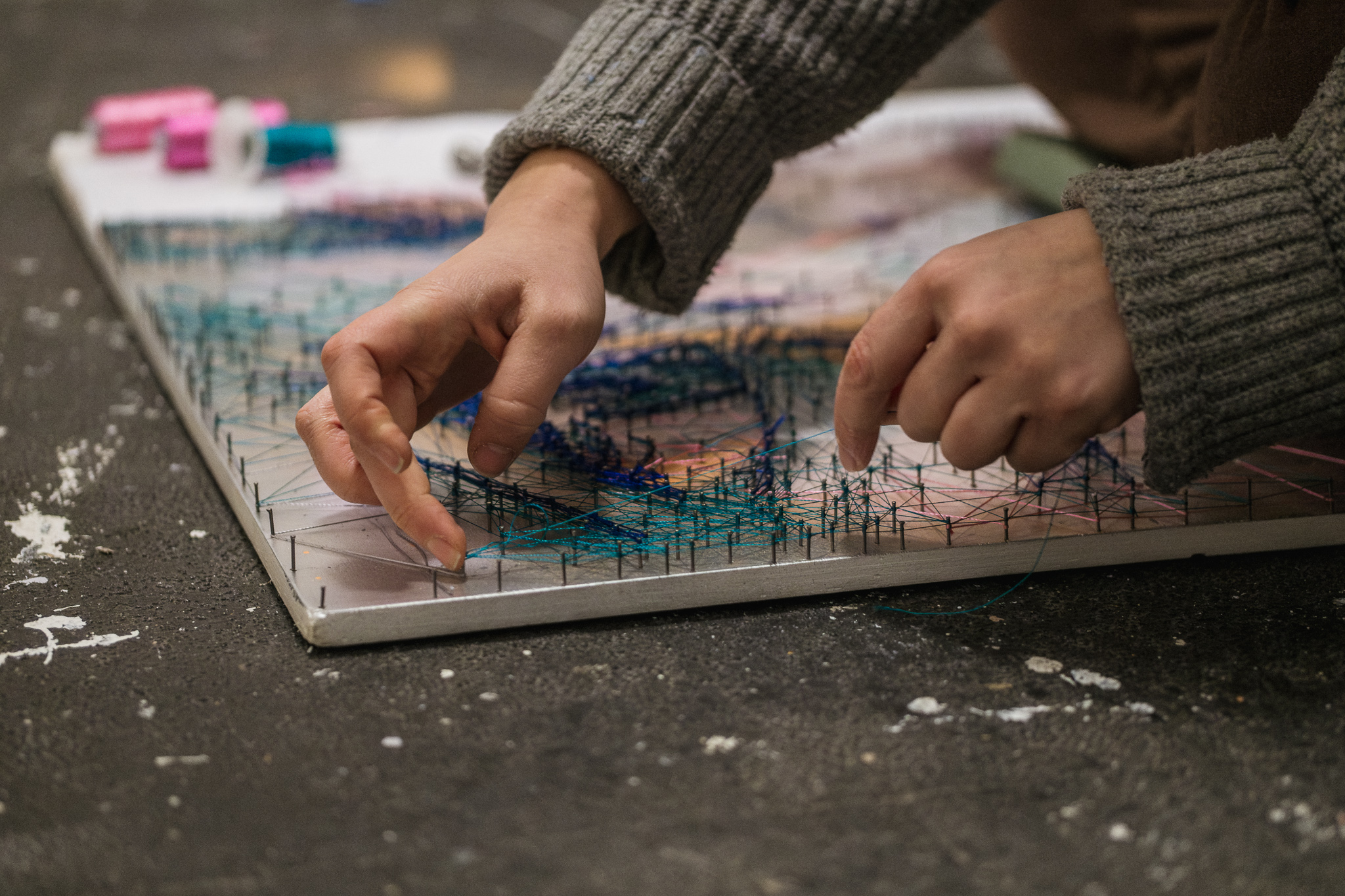Imogen Morris
︎
embroidery artist
Birmingham, UK
embroidery artist
Birmingham, UK

I REMEMBER IT being a cold and wet December day when I headed to Digbeth Art Space in Birmingham to meet Imogen Morris, an embroidery artist who goes beyond traditional threadwork to create eye-catching art pieces with just nails and thread.
In her half of a dimly-lit studio space, Imogen uses thread as her pencil, weaving large portraits that bring her subjects to life. It’s amazing to watch her work and I’m thankful for the chance to have a conversation with her as she worked.



Q: Tell us about your art journey. How did you start on using threadwork in your artwork?
I graduated in 2013 with a degree in Fine Art and Art History, where I explored every type of material (steel, cast, stone), but for about 7 to 8 years after, my art practice stopped because I didn’t have any means or money to continue. I did youth work and facilitated art workshops.
In 2018, I started doing embroidery, creating portraits just for fun. I sold them at some art fairs and got some attention on social media, but generally I found it very time-consuming.
I graduated in 2013 with a degree in Fine Art and Art History, where I explored every type of material (steel, cast, stone), but for about 7 to 8 years after, my art practice stopped because I didn’t have any means or money to continue. I did youth work and facilitated art workshops.
In 2018, I started doing embroidery, creating portraits just for fun. I sold them at some art fairs and got some attention on social media, but generally I found it very time-consuming.
I really love working with materials, and exploring the scope of what you can do with it. With thread I wanted to push beyond embroidery hoops, and explore how versatile it can be.
So when a friend of mine suggested I try a new method combining thread with nails, I decided to attempt an ‘eye’ design, and that’s how my current art practice began.
So when a friend of mine suggested I try a new method combining thread with nails, I decided to attempt an ‘eye’ design, and that’s how my current art practice began.


Q: How is your art process like? And how long does it take to make each art piece?
I think my technique has evolved over the years to become more detailed. My earlier work was unintentionally abstract, but now I enjoy working on the details, like for example, the close-up features of a face. These are far more interesting to a buyer and to me.
I think my technique has evolved over the years to become more detailed. My earlier work was unintentionally abstract, but now I enjoy working on the details, like for example, the close-up features of a face. These are far more interesting to a buyer and to me.
First, I usually start with a drawing. I tend to work from a photo as reference, especially for portraits. Then I place the nails on essential points in the image. Next, I’ll wrap thread around the nails, to create the contours of the face and build up layers to create depth and details. This threading part is rhythmic and meditative, and I’ll repeat this till I build up an accurate representation.
Depending on the details required for each piece and its size, I think I usually take about 30 to 40 hours for a piece? If the piece requires painting, that takes time as well.
Depending on the details required for each piece and its size, I think I usually take about 30 to 40 hours for a piece? If the piece requires painting, that takes time as well.


Q: I realise that some of your art work is kind of large scale, with the threads being pulled out at the end.
Are these difficult to make/sell?
I actually really enjoy bringing my work to art fairs, because people are really intrigued by the use of thread. Due to the nature of my art, it will appear different in every space. It is also near impossible to just buy and bring it home. And it definitely needs to be installed.
While installation is generally not difficult (I only require some minor plates), commissions for people’s homes are rare.
I actually really enjoy bringing my work to art fairs, because people are really intrigued by the use of thread. Due to the nature of my art, it will appear different in every space. It is also near impossible to just buy and bring it home. And it definitely needs to be installed.
While installation is generally not difficult (I only require some minor plates), commissions for people’s homes are rare.
That said, I have done one before, for a buyer in Italy. It was my first proper sale and he flew me out there to install it in his home.
It takes a buyer who is risky and really loves the effect of my threadwork, because it can look strange and out-of-place. Thankfully this client had an outlandish style and felt my artwork fit into his carefully curated home.
It takes a buyer who is risky and really loves the effect of my threadwork, because it can look strange and out-of-place. Thankfully this client had an outlandish style and felt my artwork fit into his carefully curated home.


Q: How do you feel about commissions vs personal work?
It’s hard to say. Commissions get more income but it’s always a fine balance between creative fulfilment and creative control. Personally, I’d like to stop commissions in the next three years, and move towards a completely sustainable art practice.
But there’s still lots I have to learn. I’m inspired by artists like Sophie Tea, who approach their art as a business. I’m also grateful for the support I’ve received, from people like Princes Trust, and Kay who runs Digbeth Art Space, who advise me about the business side of my practice, like pricing, marketing and other opportunities. For example, different pieces work in different contexts: prints are more affordable and easy to replicate, compared to large scale art work that needs to be intalled. These are what I need to think about if I want to make my art practice sustainable.
It’s hard to say. Commissions get more income but it’s always a fine balance between creative fulfilment and creative control. Personally, I’d like to stop commissions in the next three years, and move towards a completely sustainable art practice.
But there’s still lots I have to learn. I’m inspired by artists like Sophie Tea, who approach their art as a business. I’m also grateful for the support I’ve received, from people like Princes Trust, and Kay who runs Digbeth Art Space, who advise me about the business side of my practice, like pricing, marketing and other opportunities. For example, different pieces work in different contexts: prints are more affordable and easy to replicate, compared to large scale art work that needs to be intalled. These are what I need to think about if I want to make my art practice sustainable.


Q: Do you have a favourite art piece of your own?
There are a few. I did a deconstructed acrylic piece for an exhibition called ‘We Make Mistakes’ at The White Hotel in Manchester. That piece was challenging and really pushed my practice.
There’s also the first piece I created that had thread coming out of it. I made that in the summer of 2022 at a London residency. It felt experimental and was a fresh focus for me.
There are a few. I did a deconstructed acrylic piece for an exhibition called ‘We Make Mistakes’ at The White Hotel in Manchester. That piece was challenging and really pushed my practice.
There’s also the first piece I created that had thread coming out of it. I made that in the summer of 2022 at a London residency. It felt experimental and was a fresh focus for me.
Q: What are you working on or towards for your art?
I’m focusing on refining my nail and thread technique, and now I’m also playing with colour and paint behind the thread art work. The current colour palette is a mix of pinks, greens, blues and peaches. I love how the paint creates a layer that interacts with the thread, it highlights the general outline of the face, while the thread adds the details.
On the business side, I’m working on figuring out what appeals to potential customers, and how to make art that has impact. I’m musing about more sculptural work, and how to move from 2D art work to 3D.
I’m focusing on refining my nail and thread technique, and now I’m also playing with colour and paint behind the thread art work. The current colour palette is a mix of pinks, greens, blues and peaches. I love how the paint creates a layer that interacts with the thread, it highlights the general outline of the face, while the thread adds the details.
On the business side, I’m working on figuring out what appeals to potential customers, and how to make art that has impact. I’m musing about more sculptural work, and how to move from 2D art work to 3D.


I love how Imogen speaks so practically about her art practice, constantly bringing up the business side of things in our conversation. It just makes me realise how each artist is also a small business owner or entrepreneur, and that it’ll take time to figure what works for them and their art practice.
I also love how her unique threadwork can be seen as a mastery of craft as well as belonging in the realm of fine art. Her larger portrait installations are stunning and make me stop to look closely at the details that her threads highlight. I love how she’s carved out a niche for herself that makes her threadwork stand out from traditional embroidery, and can’t wait to see where she takes her art.
Follow:
Imogen Morris
https://www.imogenmorrisart.com
https://www.instagram.com/imogenmorrisart
︎
Visited December 2023, published December 2024.
Imogen Morris
https://www.imogenmorrisart.com
https://www.instagram.com/imogenmorrisart
︎
Visited December 2023, published December 2024.